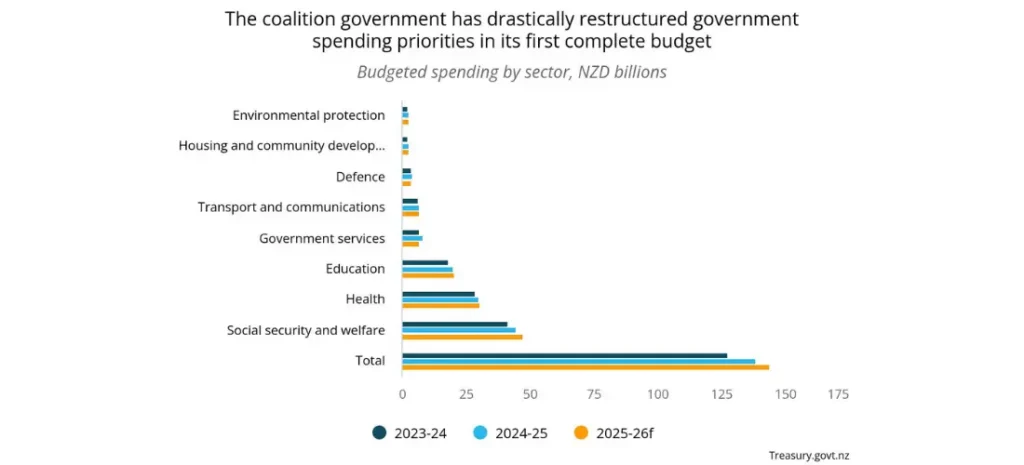
The new administration has prioritized tax cuts and a contraction of the public sector in its first annual budget
On balance, the upcoming budget is not expected to meaningfully improve consumer demand. The increase in demand from the tax cuts to most Kiwi households will be offset by the job losses that are set to take place in the public sector. B2B and B2G firms should prioritize demand opportunities created by the government’s investments into infrastructure, regional development, and rebuilding efforts. This is one of the few sectors where the government has committed to increasing funding in the near term. Apart from infrastructure, firms should expect government spending in other areas to remain flat. The medium-term fiscal targets set in this budget leave very little room for further investments and will likely even lead to further funding cuts. Finally, all firms with government contracts should expect turbulence within the public administration over the next year. Investing more time in communicating with public agencies to ensure that personnel transitions do not impact the execution of existing contracts may be necessary.
Overview
New Zealand’s 2024-25 budget did not contain any major surprises. The coalition government mainly prioritized its campaign promises of providing tax cuts and reducing government spending. The fiscal health of the government is also a key theme of this budget; however, the projected savings are only expected to kick in after three years. In the short term, the budget is still expansionary— growing by 8.4%, from NZD 127.5 billion in FY 2023-24 to NZD 138.3 billion this year.
The key changes of this year’s budget include:
- Tax relief: This year’s budget provides NZD 2.6 billion in tax relief (totaling NZD 14.7 billion over five years) through upward adjustment of tax brackets to account for inflation. Another NZD 1.1 billion will be spent on tax credits for independent earners, young families, and interest deductions for residential rental property.
- Funding cuts: Reducing government spending remains a key pillar of the coalition government. To that extent, this budget sees funding across government agencies that total NZD 4.15 billion annually. The most significant budget cuts come from scrapping previous programs designed by the Labor party (especially those related to climate change) and through over 4,000 job cuts in the public service.
- Infrastructure: The budget allocates NZD 1 billion over four years to invest in roads of “national significance.” Another NZD 939 million will focus on repair works for roads damaged during Cyclone Gabrielle and other natural disasters over the past years. Over NZD 460 million will also be spent on upgrading the national railway network, with a focus on Auckland and Wellington. NZD 1.2 billion is allocated toward the Regional Infrastructure Fund to invest in resilience infrastructure and an extra NZD 1 billion will go toward the National Land Transport Fund. Finally, the budget also includes the creation of a National Infrastructure Agency, though all details on this are not yet available.
- Healthcare: While the Ministry of Health is expected to lose 134 jobs, the sector will see increased funding of NZD 8.2 billion over four years. This will include NZD 1.8 billion for Pharmac, NZD 3.4 billion for hospitals and specialty services, and NZD 2.2 billion for primary care and public health.
- Law and Order/National Defense: The coalition’s priority to support law and order will result in NZD 1.9 billion going toward funding for correctional facilities and officers. NZD 429.9 million for frontline policing, and NZD 226 million to create an extra 500 jobs on the police force. NZD 570 million has also been earmarked for increasing pay in the armed forces and to upgrade equipment.
Our View
Between the mid-year budget update at the end of the last year and the FY 2024-25 budget, the new coalition government has altered the shape of public spending in New Zealand. The administration has put policies in place that reduce the scope of public agencies, lower taxes across sectors, and reverse the previous administration’s focus on climate policy. Under the Nationals-led coalition, the government aims to be more streamlined and pro-business. This budget represents that idea with a major reallocation of government resources across sectors. Most significantly, funding for climate policies and public services has been slashed, while greater resources are going to fund tax cuts, law and order, and infrastructure projects.
The other key question around the budget is whether it is inflationary. Critics argue that more money for households will drive up inflation and force the central bank to maintain higher rates for longer. However, we do not expect this to be the case. Since the funding for the tax relief measures is offset by spending cuts in other areas, on balance, the budget should be neutral. Moreover, due to the erosion of purchasing power that has taken place in the past two years, households are not able to dramatically increase spending because of these tax cuts. Inflationary pressures, if any, are likely to be restricted to a select few product groups.
Finally, the budget documents also signal that public finances will be in a surplus by FY 2027-28. The budget deficit is expected to grow in the near term as the government adapts to the changes in tax rates and changes to its spending priorities. The funding cuts are also designed in a way that they pay off over the next four years, rather than in the immediate term. However, the expenditure forecasts listed in the budget are slight, with an average growth of 3% YOY from FY 2025-26 onward. These spending parameters leave the government with limited room to maneuver, especially as New Zealand’s aging population will lead to rising social security and healthcare costs. Treasury officials also pointed out that the projected expenditures are unlikely to cover the cost of existing public services. As a result, the coalition government will either need to reconsider its plans to achieve a budgetary surplus in the coming years, or we will see consistent austerity and strict funding cuts in the years ahead.
At FrontierView, our mission is to help our clients grow and win in their most important markets. We are excited to share that FiscalNote, a leading technology provider of global policy and market intelligence has acquired FrontierView. We will continue to cover issues and topics driving growth in your business, while fully leveraging FiscalNote’s portfolio within the global risk, ESG, and geopolitical advisory product suite.
Subscribe to our weekly newsletter The Lens published by our Global Economics and Scenarios team which highlights high-impact developments and trends for business professionals. For full access to our offerings, start your free trial today and download our complimentary mobile app, available on iOS and Android.

